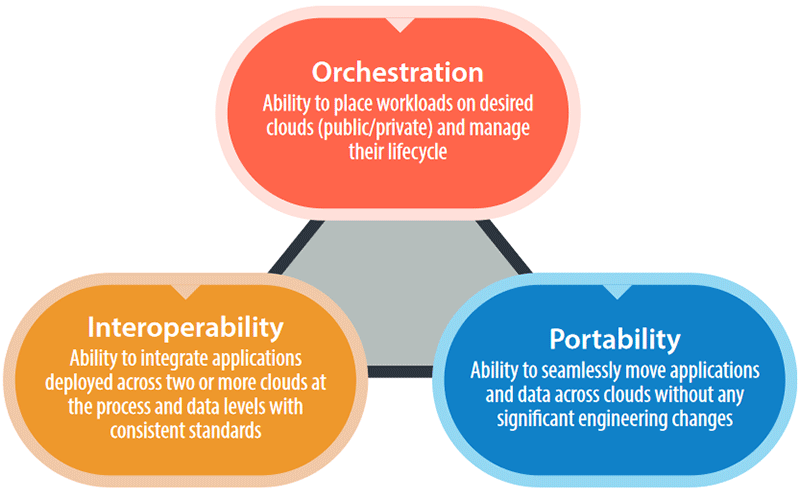Insights
- Multi-cloud delivers growth, innovation, and productivity. However, as companies work with different cloud service providers (CSP), they must deal with several cloud management standards. Managing multi-cloud workload requires specialized skillsets, robust data security, regulatory compliance, and cost controls.
- To achieve desired business outcomes, using the right mix of three models – orchestration, interoperability, and portability becomes crucial. These models can be used independently or in conjunction with each other based on business requirements.
- Factors including size of business, geographic expanse, industry, and most importantly business objectives play key role in defining the optimal multi-cloud setup.
- For long-term success, it is important to build a model that is flexible and can adjust to future changes in customer expectation, regulations, business objectives, and CSP capabilities.
Multi-cloud is the new frontier
The cloud is a powerful tool used to drive innovation, productivity, and efficiency. But as more vendors enter the market with increasingly sophisticated offerings, the choices can be overwhelming. The three major service providers — Google, Amazon, and Microsoft — have comparable core cloud offerings, but all have different strengths.
Matching business requirements to these offerings typically results in a company forging multiple cloud relationships. According to Infosys’ Cloud Radar 2021, 93% of companies use at least two cloud service providers (CSPs) and 82% use at least three.1 This is not a bad thing. Companies with three or more CSPs achieve better cloud performance than the ones using one or two service providers, the research found. It’s the flexibility that multi-cloud enables that drives this better outcome.
For example, different vendors have different geographic or functional strengths. One might be great for your advanced data analytics requirements, while another may be better to support geographic expansion. They all are innovating in different ways as well. So, having a relationship with more than one or two can give you access to a wider range of new tools. This can also provide more resilience against instances of outages at one public cloud vendor. Finally, multi-cloud also promotes competition among cloud vendors and can help clients negotiate better prices and services.
Businesses are flocking to multi-cloud as it enables growth, innovation, and productivity
Complexities of multi-cloud
While multiple clouds are productive, operating workloads across CSPs involves several challenges. Companies need to effectively address requirements from several stakeholders, including business, IT, security, customers, and regulators. The key strategy is to strike the right balance between business requirements, internal and external compliance needs, cloud capabilities, and cost. For example, a leading global bank that Infosys works with uses Google Cloud Platform (GCP) for data processing, while — for a resilient mobile banking platform — it uses Amazon Web Services (AWS). Collectively, these cloud services provide the bank with the ability to support its current applications and emerging niche requirements.
Business and IT leaders face the following challenges while laying out the optimal multi-cloud adoption strategy:
- Multi-cloud management: With increase in number of public cloud vendor relationships, the complexity of managing applications and infrastructure increases. Given the lack of standardization across vendors in terms of portals, application programming interfaces, and processes, significant cloud management bandwidth is required.
- Data security: Although CSPs have heightened protection against security threats, managing strong security controls is a challenge.
- Specialized talent: Rapid technological development and management of applications across cloud platforms require specialized talent.
- Compliance: As each cloud is deployed differently, CSPs need to adhere to stringent compliance requirements (such as GDPR, PCI, PII, and HIPAA).
- High cost: Businesses can lose track of cloud inventory or applications if not managed properly, bumping up costs and building inefficiencies.
Three models to successfully adopt multi-cloud
Business and IT leaders should collaboratively build a framework for an optimal multi-cloud arrangement. This framework can help businesses choose the best strategy (see Figure 1), based on size, industry, geography, and business-IT objectives.
Infosys’ multi-cloud decision framework is based on three adoption models: orchestration, interoperability, and portability. The model helps enterprises cut through the complexities and derive maximum value.
Figure 1: Multi-cloud adoption models

Source: Infosys
These models should not be treated as maturity levels and can be concurrently applied in an enterprise across its portfolios or application clusters. Organizations can choose one or more strategies, depending on their business requirements and potential use cases.
Orchestration
Orchestration is the ability to place workloads on desired public or private clouds and automate the lifecycle management to minimize operation and management complexities. It enables organizations to uniformly enforce security, technical, and operational policies on workloads; ensure compliance; and provide cost transparency. Orchestration as a strategy would be sufficient when the workloads deployed in each cloud can operate independently and are economically viable.
For example, an enterprise can deploy support functions such as HR, payroll, and finance on one CSP, and manufacturing and supply chain on another. Typically, the integration requirements for such multi-cloud setups would be minimal and building orchestration capabilities would be enough.
Interoperability
Interoperability allows workloads to be deployed across multiple clouds, providing a seamless user experience and reducing management complexities. The interoperability system needs capabilities for standards-based process/data exchanges between applications, and a unified toolset for developers and system operators. It is a necessity when workloads across clouds are interdependent to deliver business outcomes.
For example, a retailer could have product management and sourcing deployed on one cloud, while e-commerce and order management are on another due to compatibility issues. These systems need to work seamlessly to ensure the customer’s delight, from browsing products to ordering and delivery.
Portability
Portability provides for the ability to move workloads from one cloud to another without having any impact on the expected business outcomes. Engineering for portability requires substantial upfront investments, so that enterprises can continue their innovation journey leveraging CSP capabilities. Portability is essential when enterprises need complete control of the technology stack to support needs like business growth across borders, business continuity, and regulatory compliance.
A global financial and credit card company, which was leveraging advanced technology to develop unique and compelling products, was using multi-cloud to support its global operations and scalability needs. It invested in cloud platform engineering to create capabilities to “develop once and deploy globally” its application portfolio seamlessly across multiple clouds.
Choosing the right strategy
Choosing the right mix of multi-cloud model requires careful forethought and discipline across multiple dimensions. The most important aspects here include the size of the business, industry, geographic expanse, and business objectives. Companies need to weigh all these dimensions simultaneously to make what is a very critical choice to ongoing business health (see Figure 2).
Figure 2: How to choose the right cloud strategy

Source: Infosys
Let’s explore these four dimensions one by one:
Size of the company – This dimension determines the IT budget, team size, and expertise available within an organization to execute complex multi-cloud strategies. Multi-cloud is expensive in terms of both cost and time investment. A small to medium-sized company with limited resources could aim to meet its IT needs from a single CSP and maximize efficiency through orchestration. A medium-sized to large enterprise that wants to use IT for competitive differentiation may require services from more than one CSP to meet its diverse needs. Such enterprises should start thinking about interoperability across multiple clouds. Finally, a large enterprise with a sizable IT budget, organizational capabilities, and skilled workforce can afford to plan for portability across multiple clouds, if required.
Geographic expanse – The CSP’s service availability and data and security regulations vary by region. A company operating in a single country or region may find a single CSP optimal for its service requirements. With a single CSP, it can focus on orchestration to maximize operational efficiency and avoid the overheads of multi-cloud management. However, if a company has multi-region operations, and if some of the desired services are not available from its primary CSP across regions, it may have to choose a secondary CSP (or even a tertiary CSP) to meet all its needs. Some organizations with multi-geo operations may choose to put their geography-specific workloads on different clouds for better performance or to meet regulatory requirements. However, these workloads might have to work together to deliver collective business outcomes. For such companies, the need to integrate business operations across multiple clouds will demand cloud interoperability. Finally, some CSPs may be present in only one location within a country (e.g., in Australia, AWS is present only in Sydney2). If a company is already on such a CSP and strong data residency restrictions may come up in the future. Here, the company will be required to build capabilities with another CSP in a different region of that country (e.g., Azure is present in three zones in Australia3) and build portability from the primary CSP to the secondary one for disaster recovery.
Certain industries’ regulations might also push companies to adopt multi-cloud with interoperability and/or portability for business continuity and information security reasons. One such case example comes from China, where regulations restrict cloud data hosting outside the country. The country is a global supply chain hub, and businesses around the world deal with China-based companies. These businesses will have to opt for interoperability to ensure their applications run smoothly while meeting local regulatory requirements.
Industry – This dimension is important, as it drives the industry-specific IT needs and regulatory requirements. For industries like utilities and materials, IT is largely a cost center. With a focus on cost and operational efficiency, orchestration with a single CSP is the most appropriate strategy for them. For industries such as healthcare, retail, and CPG, IT has been driving higher business value by improving product offerings, optimizing supply chains, and reducing service costs. Companies from these industries can afford to maximize cloud services across multiple CSPs and then integrate their business operations through interoperability. For example, in financial services, regulations already mandate that companies have an exit strategy from their primary CSP. This drives financial services companies to implement portability. Such regulations potentially will emerge in other industries as well.
Business objectives – This dimension is likely the most important driver for adopting a multi-cloud strategy. The degree to which a company’s business objective demands autonomy will drive the move toward the more complex multi-cloud strategies. For example, if the business objective is to cut cost through IT, an organization may be able to adjust its business needs from a single CSP and then maximize efficiency through orchestration. If the business objective is to grow and optimize operations through IT, the organization may choose services from multiple CSPs and integrate its business operations through interoperability. Finally, if the business objective is to transform the business through IT, the organization will need to invest in developing portability across multi-cloud.
Leaping into the future with a balanced cloud mode
Even if all businesses do not need multi-cloud, it can be a potent tool for risk mitigation, value creation, and growth. Infosys Cloud Radar 2021 highlighted that 62% of respondents indicated business growth through scaling and capability enhancements as their objective behind multi-cloud. With the constantly changing geopolitical environment, regulations, and rising customer expectations, businesses need a cloud setup that meets today’s requirements and can swiftly adjust to future changes.
Multi-cloud adoption is a multi-year journey. During this course, business needs change on the demand side and CSP services offerings on the supply side. Organizations should establish an ongoing governance mechanism to ensure a result-oriented and forward-looking multi-cloud decision framework.
References
- Infosys Cloud Radar 2021, Infosys
- Regions and Availability Zones, AWS
- Find the Azure geography that meets your needs, Microsoft





